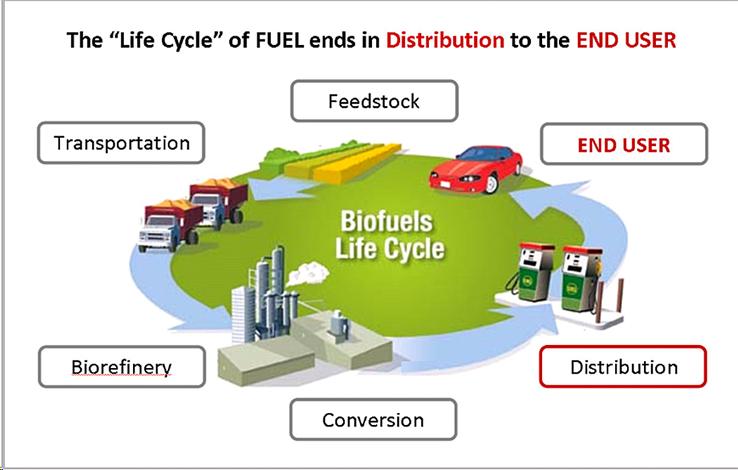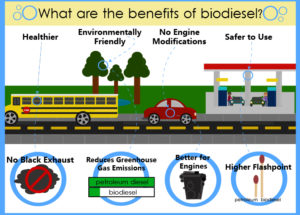Emissions & Greenhouse Gas reduction
Emissions
Biodiesel is the only alternative fuel to successfully complete the EPA’s rigorous emissions and health effects study under the Clean Air Act. Biodiesel provides significantly reduced emissions of carbon monoxide, particulate matter, unburned hydrocarbons, and sulfates compared to petroleum diesel fuel. Additionally, biodiesel reduces emissions of carcinogenic compounds by as much as 85% compared with petrodiesel. When blended with petroleum diesel fuel, these emissions reductions are generally directly proportional to the amount of biodiesel in the blend.
Close Contact Benefits from the “French Fry Fuel”
The reduced particulate and unburned hydrocarbons emissions that result when using biodiesel are a welcome relief in environments where workers and pedestrians are in close proximity to diesel engines, including public transport, mining, and construction. In addition, when high blends of biodiesel are used, the exhaust from diesel engines is often described as smelling like fried food, which aside from causing increased hunger in those nearby, is a welcome relief from the smell of diesel fuel exhaust.
A Clean Alternative Fuel for New and Old Engines
Diesel engines have long had a reputation of being “dirty” engines. However, with the advent of newer diesel engines equipped with exhaust gas recirculation (EGR), particulate filters, and catalytic converters, clean diesel technology provides incredible fuel efficiency with ultra low emissions levels. When coupled with the use of biodiesel, both new and old diesel engines can significantly reduce emissions, including particulate matter (black smoke).
A Closer Look at Emissions Reduction
Studies on biodiesel emissions have been conducted for almost 20 years. In that time biodiesel has undergone the most rigorous testing of any alternative fuel, having been the first and only fuel to be evaluated by the EPA. This study examined the impact of hundreds of regulated and non-regulated exhaust emissions, as well as the potential health effects of these emissions. Some of these results are summarized below.
| Average Exhaust Emissions for 100% Biodiesel Compared to Petroleum Diesel Fuel* | |
| Regulated Exhaust Emissions B100 | |
| Particulate Matter | -47% |
| Carbon Monoxide | -48% |
| Total Unburned Hydrocarbons | -67% |
| Nitrogen Oxides | +/- |
| Non Regulated Emissions | |
| Sulfates | -100% |
| Polycyclic Aromatic Hydrocarbons (PAH) | -80% |
| Nitrated Polycyclic Aromatic Hydrocarbons (nPAH) | -90% |
| Speciated Hydrocarbons Ozone Forming Potential | -50% |
4 “A Comprehensive Analysis of Biodiesel Impacts on Exhaust Emissions”
Explanation of Emission Types
- Particulate Matter (Black Smoke) Emissions of particulate matter have been linked to respiratory diseases and are generally considered to be a human health hazard. Emissions of particulate matter are reduced with biodiesel by 47%.
- Carbon Monoxide Carbon Monoxide is a poisonous gas. Reduced with biodiesel by 48%.
- Total Unburned Hydrocarbons Compounds which contribute to localized formation of smog. Reduced with biodiesel by 67%.
- Nitrogen Oxides Compounds which contribute to localized formation of smog. According to NREL (Biodiesel Handling and Use Guidelines 2009 revision) examination of the NOx testing results shows that the effect of biodiesel can vary with engine design, calibration, and test cycle. At this time, the data are insufficient for users to conclude anything about the average effect of B20 on NOx, other than that it is likely very close to zero.
- Sulfates Sulfates are major contributors to acid rain. These emissions are practically eliminated when using biodiesel.
- Polycyclic Aromatic Hydrocarbons (PAH and nPAH) These compounds have been identified as carcinogenic (cancer causing) compounds. Biodiesel reduces emissions of these compounds by up to 85% for PAH compounds and 90% for nPAH compounds.
- Speciated Hydrocarbons These compounds contribute to the formation of localized smog and ozone. The potential for smog formation from speciated hydrocarbons is reduced by 50% when using biodiesel.
Life Cycle Reduction of CO2
Biodiesel helps reduce the risk of global warming by reducing net carbon emissions to the atmosphere. When biodiesel is burned, it releases carbon dioxide to the atmosphere, but crops which are used to produce biodiesel take up carbon dioxide from the atmosphere in their growth cycle. A joint study conducted by the U.S. Department of Agriculture, and the U.S. Department of Energy determined that biodiesel reduces net carbon dioxide emissions to the atmosphere by 78.5% compared with petroleum diesel fuel.


